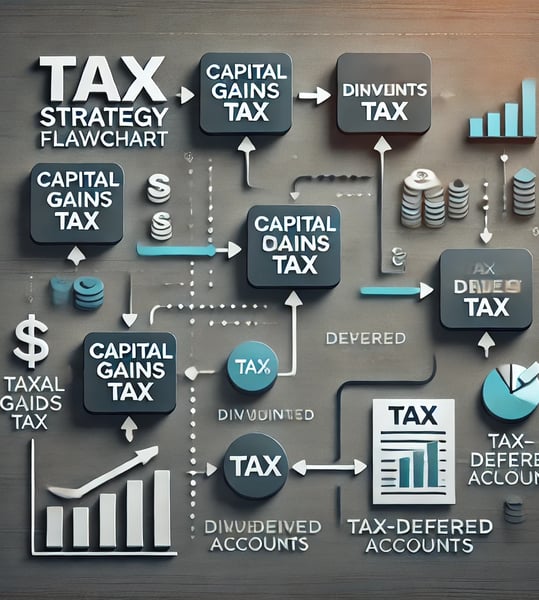Tax Strategies for Investors: What You Need to Know
11/14/20243 min read
Tax strategies are an essential part of investing. By understanding the tax implications of your investment decisions, you can maximize your returns and minimize what you owe in taxes. In this guide, we’ll cover key tax strategies for investors to help you keep more of your investment gains and improve your financial outcome.


1. Understand How Investment Income Is Taxed
One of the first steps in tax planning is understanding how different types of investment income are taxed. There are several key categories to be aware of:
Dividends: Dividends are typically taxed at a lower rate than ordinary income, depending on whether they are qualified or non-qualified dividends. Qualified dividends are taxed at long-term capital gains rates, which are lower than ordinary income tax rates.
Interest Income: Interest from savings accounts, bonds, or certificates of deposit (CDs) is generally taxed as ordinary income, which may be at a higher rate than dividends.
Capital Gains: Capital gains are profits you make from selling investments, such as stocks or real estate, for more than you paid for them. If you hold an asset for more than a year before selling, it is considered a long-term capital gain and is taxed at a lower rate than short-term capital gains.
How to minimize tax:
Invest in tax-efficient funds and accounts.
Hold investments for longer periods to take advantage of long-term capital gains rates.
2. Use Tax-Advantaged Accounts
Tax-advantaged accounts like IRAs, 401(k)s, and HSAs offer significant tax benefits for investors. By utilizing these accounts, you can defer taxes or even avoid them altogether.
Traditional IRA: Contributions are tax-deductible, and your investments grow tax-deferred until you withdraw the funds in retirement.
Roth IRA: Contributions are made with after-tax money, but your earnings grow tax-free and can be withdrawn without taxes in retirement.
401(k): Contributions are tax-deductible, and the funds grow tax-deferred until you begin withdrawing them in retirement. Some employers offer matching contributions, which is essentially free money.
How to minimize tax:
Contribute to tax-deferred accounts to reduce your taxable income in the short term.
Use Roth accounts if you expect to be in a higher tax bracket in the future.
3. Be Mindful of Capital Gains Tax
When you sell an investment for a profit, you incur capital gains tax. The rate you pay depends on how long you hold the investment and your tax bracket. Long-term capital gains (for assets held longer than a year) are taxed at a lower rate than short-term capital gains.
How to minimize tax:
Hold onto investments for longer than a year to benefit from long-term capital gains rates.
Consider tax-loss harvesting, which involves selling investments that have decreased in value to offset gains from other investments.
4. Tax-Loss Harvesting
Tax-loss harvesting is a strategy where you sell investments that have lost value to offset taxable gains elsewhere in your portfolio. By doing this, you can reduce your overall tax liability for the year. The losses you realize can be used to offset capital gains and, in some cases, even ordinary income.
How to minimize tax:
Regularly review your portfolio to identify underperforming assets that could be sold for a tax loss.
Be aware of the "wash-sale rule," which prevents you from buying back the same or similar security within 30 days of selling it at a loss.


5. Consider Dividend Stocks for Tax Efficiency
Dividend stocks can be an effective way to generate income with potentially lower taxes. Qualified dividends are taxed at the long-term capital gains rate, which is generally lower than the rate for ordinary income.
How to minimize tax:
Focus on dividend-paying stocks that qualify for the lower tax rate.
Invest in tax-efficient dividend funds to benefit from the compounded growth of dividends without incurring high taxes.
6. Consider a Tax-Deferred Annuity
An annuity is a financial product that allows you to invest money and receive regular payments over time. Certain types of annuities, like tax-deferred annuities, allow you to grow your investment without paying taxes on the earnings until you begin taking withdrawals.
How to minimize tax:
Invest in a tax-deferred annuity if you are seeking guaranteed income with tax advantages.
Conclusion
Tax strategies are an essential part of investing. By understanding how investment income is taxed, utilizing tax-advantaged accounts, and implementing strategies like tax-loss harvesting and focusing on dividend stocks, you can maximize your returns and reduce your tax liability. With careful planning, you can make your investment dollars work harder for you while keeping more of what you earn.
Take the time to understand the tax implications of your investments and make informed decisions that help you build wealth efficiently and sustainably.
Joy
Inspire your journey to happiness and fulfillment.
contact us
Growth
© 2024. All rights reserved.


